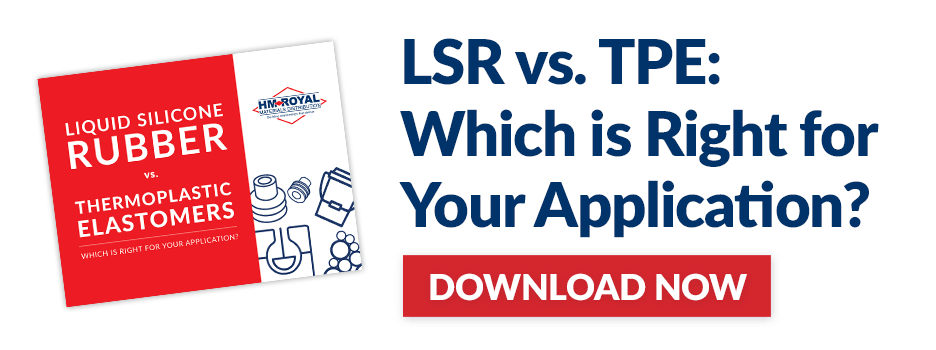RTV vs. HCR vs. LSR Injection Molding: Which is Right for Your Project?
Reading Time: 3 minutes
For many industries like automotive, aerospace and medical, it is imperative that products perform as expected, can withstand demanding conditions and be molded within tight tolerances. Because of this, manufacturers are turning to long-lasting, durable materials like silicone rubber. Silicone rubber is flexible at low temperatures and resistant to heat and aging. It is easy to process and has good mechanical properties that remain unchanged over a wide temperature range.
There are three main types of silicone rubber: room-temperature-vulcanizing silicone (RTV), high-consistency silicone rubber (HCR) and liquid silicone rubber (LSR). Choosing the right material will depend on the scale of your production and how the part is being made.
This blog shares the benefits of each type of silicone rubber, including properties, applications and uses, and tips for selecting the best material for your project.
What is RTV?
As the name implies, room-temperature-vulcanizing silicone (RTV) will cure at room temperature to form a highly elastic silicone rubber. RTV is available as a one-component (RTV-1) or two-component system (RTV-2).
RTV-1s are one-component systems that cure when exposed to atmospheric moisture. There are 4 different technologies available with unique properties to suit a wide variety of applications. The material cures from the outside in, so it will skin over first and then cure through the silicone. RTV-1s are ideal for sealing, bonding and coating applications.
RTV-2 silicone elastomers are two-part pourable/mixable materials that start to cure at room temperature shortly after mixing. Some RTV-2 materials (platinum-cured) can also be heated to achieve accelerated curing if a faster cure and demold are required. Most RTV-2s will retain their full elasticity up to 180 °C, even after long-term exposure. Some products even withstand short heat exposure up to 300 °C. RTV-2s are ideal for mold making, appliances, healthcare applications, lighting and electronics.
Both RTV-1 and RTV-2 have a long shelf life (up to 12 months) when stored at room temperature (20 to 25 °C).
What is HCR?
High-consistency silicone rubber (HCR), also known as solid silicone rubber, is cured at high temperatures with either organic peroxides or a platinum catalyst. HCR contains long polymer chains with a high molecular weight, which provides the rubber with a solid consistency. Due to its outstanding mechanical properties, HCR is used in a wide range of static and dynamic applications, including:
- Automotive
- Aerospace
- Electrical transmission and distribution
- Wire and cable
- Food processing
- Molded rubber goods
HCR provides excellent temperature and aging resistance. It can be processed using conventional methods, such as extrusion, calendering, compression and injection molding.
What is LSR?
Liquid silicone rubber (LSR) is a thermoset rubber supplied as a two-part, colorless, translucent paste that yields good clarity and excellent mechanical strength. This material offers unique characteristics that are not obtainable with conventional thermoplastic elastomers (TPEs). Once LSRs are heated and crosslinked, their chemical and physical properties can no longer be altered. This means that they will maintain their physical and chemical properties over a broad range of temperatures and environmental conditions.
LSR has a lower viscosity than solid silicone rubber (HCR). Therefore, it is pumpable and delivered as a two-component, ready-to-use system. Like all silicones, LSR is a popular option for manufacturers in many industries, including automotive, electronics, electrical transmission and distribution, mechanical goods, medical devices and healthcare consumables.
Injection molding with LSR produces consistent parts. Another advantage of using LSR is its ability to reproduce intricate and complex shapes. Since it is a low-viscosity material, it fills even the smallest spaces in the mold, making it ideal for medical and electronic applications. LSR is also ideal to use when you need to make hundreds or thousands of parts because very little labor is required during the automated production process.
Which One is Right for You?
RTV, HCR and LSR offer many of the same performance advantages. The best material for your project will ultimately depend on how many parts you need to produce. Generally, RTV and HCR materials are better suited to smaller production runs, while LSR is ideal for high-volume manufacturing or tight tolerances because it keeps unit costs down. It’s not uncommon for a company to start with RTV for prototyping and initial production and then switch to either HCR or LSR as demand grows.
If you need help selecting the right material for your application, our experts can make a recommendation. We provide a full line of Wacker silicone elastomers to meet your unique requirements.
 (800) 257-9452
(800) 257-9452



